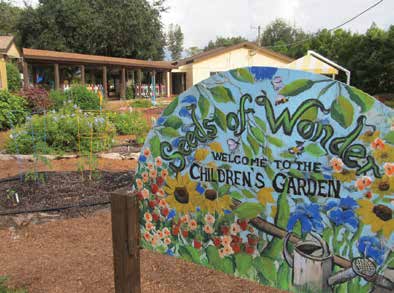Green Thumbs, Good Hearts
by Karen Coney Coplin
March may have St. Patrick’s Day, but springtime in April offers two opportunities to celebrate “greenery” – Earth Day on April 22 and Arbor Day on April 24. The latter, a holiday since 1872, traditionally encourages planting of trees; the former might be celebrated in a similar fashion or in other ways of demonstrating environmental awareness, like clearing the waterways of trash.
“When is the best time to plant a tree? Twenty
years ago. When is the second best time? Today.”
-Chinese proverb
 The Naples Botanical Garden has taken an active role, year round, with the preservation of unique and significant trees. The “Legacy Tree” program is designed to save trees which otherwise will be lost to site-clearing and demolition for the construction of new homes and businesses.
The Naples Botanical Garden has taken an active role, year round, with the preservation of unique and significant trees. The “Legacy Tree” program is designed to save trees which otherwise will be lost to site-clearing and demolition for the construction of new homes and businesses.
Notable palms and other trees in the community can put their roots down, anew, at the Naples Botanical Garden – provided that a homeowner or “other who is aware of trees that may have historical significance or are special in some other way, and, are in danger of removal,” gets in touch with the Naples Botanical Garden. This way, the tree may be evaluated for relocation. Liz Chehayl, the Curator of Collections, can be reached for this purpose at LChehayl@Naplesgarden.org, or at 239.643.7275.
The Garden’s new Chabraja Visitors’ Center is flanked with a tree canopy that was the bequest of long-time Garden patrons and dedicated tree collectors. This, and the Leopard Trees at the Garden’s Performance Lawn, will live on alongside many colorful plantings such as the Cardinal Tree or Fairchild’s Folly, all legacies to be appreciated by many generations of Garden visitors.
The Garden has a special interest in Sterculia species as well as Albizia niopoides, formerly known as Caribea, as future legacy trees; however, as Ms. Chehaly points out, “sometimes there are many [different species] of trees on a single lot, and we would certainly like to hear about those situations too.”
 Brian Galligan, the Garden’s Chief Horticulturist, pointed out that even if a tree does not qualify as a “Legacy Tree,” it can be simple and cost effective to relocate trees from their present location within the boundaries of a lot. This also can be safer than replacing trees with “new” specimens which may be root bound from being potted for a long time. “A tree’s life span will exceed ours in most cases,” he stated, suggesting that the relocation of mature specimens within a lot makes sense from a time standpoint (the tree is already mature) and, takes home safety into account (root systems for welldeveloped trees provide needed support during windstorms). Plus, an existing tree has already proven its suitability to an existing location i.e., the lot which otherwise would be clear cut.
Brian Galligan, the Garden’s Chief Horticulturist, pointed out that even if a tree does not qualify as a “Legacy Tree,” it can be simple and cost effective to relocate trees from their present location within the boundaries of a lot. This also can be safer than replacing trees with “new” specimens which may be root bound from being potted for a long time. “A tree’s life span will exceed ours in most cases,” he stated, suggesting that the relocation of mature specimens within a lot makes sense from a time standpoint (the tree is already mature) and, takes home safety into account (root systems for welldeveloped trees provide needed support during windstorms). Plus, an existing tree has already proven its suitability to an existing location i.e., the lot which otherwise would be clear cut.
The Naples Botanical Garden’s hard work runs the gamut of saving trees with character, to building character. School kids can participate in “Collier Greens,” a gardening support organization which works with over 5000 school kids in the community. Through Collier Greens, the Naples Botanical Garden helps schools develop gardens though mentoring, gardening classes, and fundraising.
One very involved teacher, Susan Paul-Decaster, of Laurel Oak Elementary, was just awarded a Golden Apple Award for engaging her third grade students with hands-on learning projects, inquiry and observation of her classroom’s STEM (Science, Technology, Engineering and Math)-based garden.
“To plant a garden is to believe in tomorrow.”
– Audrey Hepburn
Why else should kids learn to garden? In keeping with upcoming Earth Day, gardening helps students understand and respect our environment, while providing instruction on the care of living things. Kids can also develop patience as the garden grows and acquire a taste for home-grown vegetables and fruits. At the same time, they can experience the outdoors and all that it promotes: physical activity and an appreciation for nature.
Avalon Elementary, which is located in close proximity to the Garden, began a Global Garden program in 2003, which has served as a springboard of sorts for the Collier Greens program with outreach to many other schools. Several nearby elementary schools, like Parkside and Shadowlawn, have built and tended gardens on campus. The Shadowlawn school garden is notable for having donated over 50 lbs. of harvested food to St. Matthew’s House already.
The Garden’s Youth Program Manager, Britt Patterson-Weber, can be reached via email at: BPatterson-Weber@naplesgarden.org, with questions or to lend support. There are many ways to be a part of the Collier Greens initiative, whether by providing a year’s worth of seeds ($250) or building a school yard garden ($2,500) – or underwriting a garden workshop for 25 local teachers thereby seeing your gift exponentially increase, as this gift, of $1000, touches 500 students.
The Garden is beginning its third decade of service to the community, having preserved 170 acres of land from development, as an oasis of nature, education, conservation, artistic endeavors and more. From the Garden’s website naplesgarden.org: “In the next twenty years, 2.6 million acres of Florida land are likely to be converted to urban use, making Southwest Florida’s remaining green spaces all the more precious to future generations.” Saving a tree today, and teaching a kid how to garden, bodes well for our collective, indeed, connected future.
Email Karen at NaplesKCC@gmail.com. Karen moved to Naples in 1994, where then as an attorney she incorporated the Naples Botanical Garden as a pro bono act of public service. Connie Alsbrook, a longtime Naples resident, was part of a group of founding Naples Botanical Garden members who sought legal counsel, approaching Karen, Steve Thompson, Esq. and Jennifer Nackley, Esq., to create the Garden. The Garden today is a testament to these early goals, and, the promise of a vibrant future.



Leave a Reply
Want to join the discussion?Feel free to contribute!